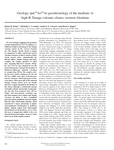Tanaga 19200 yBP
Start: 19200 yBP ± 7600 Years [1]
Event Type: Effusive
- Lava flow [1]
Description: From Jicha and others (2012): "The East Tanaga cone is less rugged and lower than Tanaga volcano, reaching 1584 m. Its summit is relatively flat and topped by a shallow, 250-m-wide crater. The cone is composed predominantly of blocky, amphibole-bearing basaltic to andesitic lavas (unit tel; Fig. 3 [in original text]) that extend to the shore on the northern side of the island and fill in a flat-bottomed amphitheater to the south. Most East Tanaga lavas are Holocene in age based on their intact surface morphologies. One lava sample collected from the base of a sea cliff on the northern flank gave a 40Ar/39Ar age of 19.2+/-7.6 ka, indicating that the volcano is at least as old as latest Pleistocene. A young buff-colored, amphibole-bearing lapilli fall deposit, found on or near the surface in several locations on northwestern Tanaga Island, thickens toward East Tanaga’s summit suggesting it originated from there."
References Cited
[1] Geology and 40Ar/39Ar geochronology of the medium- to high-K Tanaga volcanic cluster, western Aleutians, 2012
Jicha, B.R., Coombs, M.L., Calvert, A.T., and Singer, B.S., 2012, Geology and 40Ar/39Ar geochronology of the medium- to high-K Tanaga volcanic cluster, western Aleutians: Geological Society of America Bulletin, v. 124, n. 5/6, p. 842-856, doi:10.1130/B30472.1 .Complete Eruption References
Geology and 40Ar/39Ar geochronology of the medium- to high-K Tanaga volcanic cluster, western Aleutians, 2012
Jicha, B.R., Coombs, M.L., Calvert, A.T., and Singer, B.S., 2012, Geology and 40Ar/39Ar geochronology of the medium- to high-K Tanaga volcanic cluster, western Aleutians: Geological Society of America Bulletin, v. 124, n. 5/6, p. 842-856, doi:10.1130/B30472.1 .
